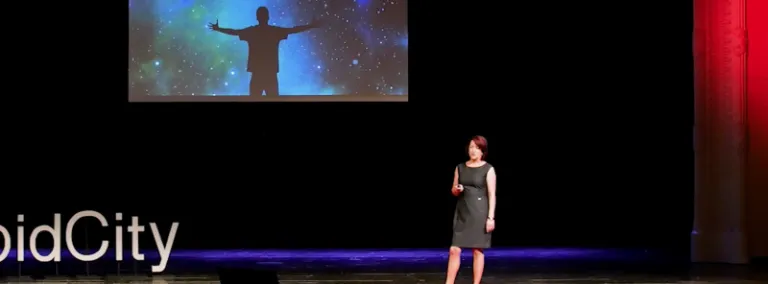Making a case for curiosity
Cabot-Ann Christofferson's Neutrino Day talk focuses on the "why" behind experimental research
“What exactly is all this good for?”
It’s a question Cabot-Ann Christofferson gets during most site visits to the 4850 Level of Sanford Underground Research Facility (Sanford Lab). As a researcher with the Majorana Demonstrator and task leader of electroforming for the next-generation LEGEND experiment, Christofferson spends a lot of time explaining what discoveries these experiments are hoping to make. However, she spends a surprising amount of time explaining why researchers are pursuing these answers in the first place.
“People often ask, ‘What is this good for? Why are you spending so many resources in pursuit of something intangible and theoretical?’” Christofferson said. “And these questions show just how narrow-minded our culture’s view of research has become.”
Christofferson first tackled this question comprehensively in a TEDx talk entitled “The Case for Curiosity” in Rapid City in 2017. Now, she is bringing the talk to Neutrino Day: A Cosmic Symphony, Sanford Lab’s free, citywide science festival on Saturday, July 13 in Lead, SD. At 11 a.m. at the Historic Homestake Opera House, Christofferson will present her case, demonstrating the importance of scientific inquiry.
“My talk addresses advances that have come from simply asking questions about how things work,” said Christofferson. “It explores reasons for humanity’s curiosity and why it’s good to be curious, even if you don’t find what you were looking for in the first place.”
Christofferson’s talk challenges the idea that experiments are only successful if researchers find the one thing they were directly attempting to detect. With examples ranging from the Super Soaker water gun to life-saving MRI technology, she will show how often advancements are made when researchers stumble across a discovery while looking for something else entirely.
“The fact that a scientist was once curious about magnetic resonance is the reason you can go to the doctor and be imaged by an MRI,” said Christofferson. “That medical technology came out of research that was completely unrelated. At the time it was discovered, researchers said they didn’t know what it was good for. Now, it’s a common-practice, life-saving measure.”
At Sanford Lab, researchers are trying to understand rare forms of radioactive decay, the nature of dark matter, the lifestyles of extremophiles and element formation in the heart of faraway stars. These projects—experimental explorations of theoretical concepts with largely unknown direct implications—are simply tests created by curious humans.
At Neutrino Day, Christofferson will connect the need for curiosity to the science happening every day at Sanford Lab.
“Many people don’t realize how much they benefit each day from those who are willing to ask questions and seek answers,” said Christofferson. “This talk is about celebrating just how much is born out of basic research.”
Neutrino Day: A Cosmic Symphony highlights the value of collaboration between the arts and sciences. In addition to a host of activities throughout the City of Lead, this year's all-day event will feature “The Legend of the Northern Lights,” a film that combines visual imagery and music to tell the story behind the Northern Lights phenomena. The film is a collaboration between Dr. Jose Francisco Salgado and the Black Hills Symphony Orchestra. The performance includes a narrator; the Orchestra will perform live.
